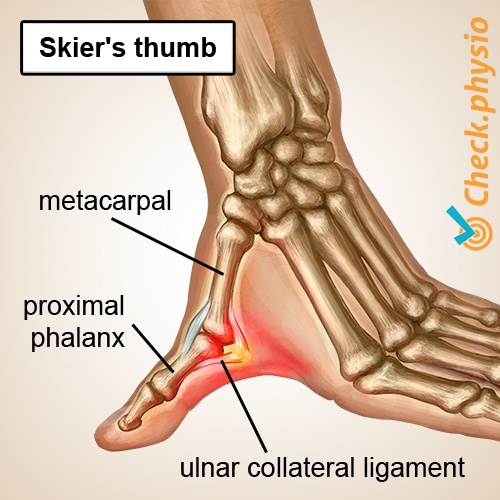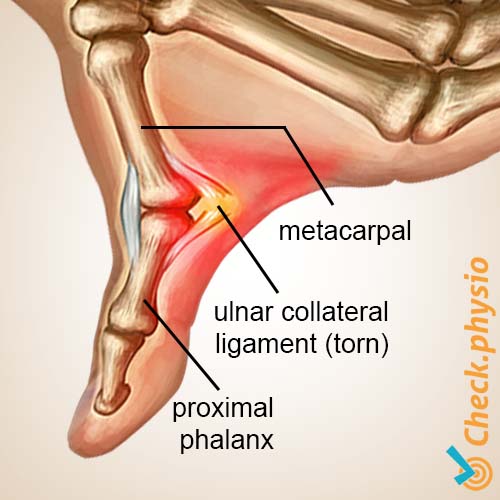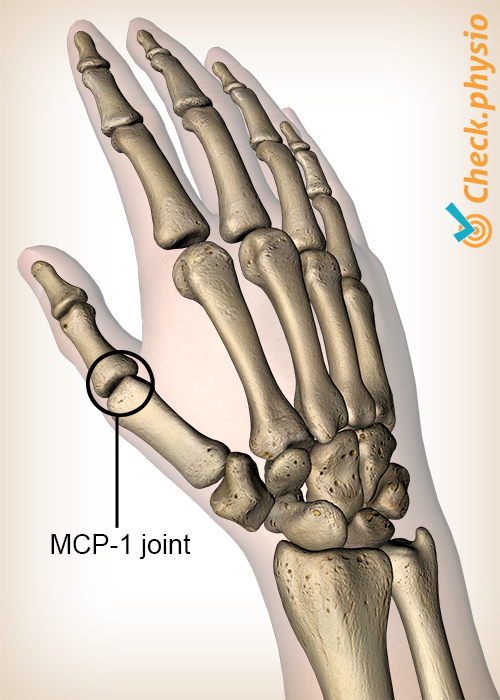- Conditions
- Skier's thumb
Skier's thumb Gamekeeper's thumb / ulnar collateral ligament injury
Introduction
In the case of skier's thumb, a ligament in the thumb joint is damaged. The symptoms usually develop following dislocation of the thumb. This can occur as the result of a fall or if the thumb is bent outwards after being hit by a ball when playing sport.
Skier's thumb is the most common arm injury in skiers. The name is somewhat confusing, as the symptoms can also occur in other sports and activities. Specialists therefore prefer to use the term 'collateral ulnar ligament injury'.

Description of the condition
The joint in the thumb that is affected is called the MCP-I joint. This is the joint where the thumb originates from the hand. The MCP-I joint is supported by a capsule and ligaments on all sides. These structures provide sturdiness and prevent incorrect movements from occurring in the joint. The joint ligament that is located on the inside of the thumb is called the 'collateral ulnar ligament' of the MCP-I joint. It is this joint ligament that is damaged in the case of skier's thumb.
The collateral ulnar ligament can sprain or tear if the thumb is struck by a significant force that is directed outwards. If the joint ligament tears completely this is called a 'rupture'. The thumb can then make abnormal outward movements, because the collateral ulnar ligament no longer blocks these movements.
Cause and origin
A classic cause of skier's thumb is a fall whilst skiing in which the thumb hooks behind the ski pole. Hockey players can suffer the same injury by falling with the hockey stick in hand. Another cause is when the outstretched thumb is hit by a ball whilst playing sport and the thumb is then 'bent' too far outwards.
These symptoms can also not be caused by a trauma (accident or fall). Activities that involve repetitive stretching of the collateral ulnar ligament can also cause damage to the joint ligament. This is the reason that it is also referred to as 'gamekeeper's thumb'; In the past, hunters used a brief movement of the thumb to twist the neck of birds or rabbits. This repetitive movement causes damage to the collateral ulnar ligament.
Signs & symptoms
- Pain on the inside of the thumb at the site of the MCP-I joint (see image).
- Pressing on the inside of the thumb joint is painful.
- Pain with thumb movements or when twisting a jar or doorknob open or shut.
- Swelling of the MCP-I joint (particularly after a trauma).
- Feeling of instability in the thumb joint.
- If the collateral ulnar ligament is ruptured completely, the thumb can make abnormal outward movements.
Diagnosis
A healthcare professional asks about the complaints and how they arose. During the physical examination, swelling, tenderness, mobility, and stability of the thumb are assessed.
Since a skier's thumb is often associated with an avulsion fracture, taking an X-ray is often necessary. The size of the torn-off bone fragment determines whether surgery is needed or not. An ultrasound can quickly clarify the damage to the ligament in practice. An MRI visualizes the thumb best, though it often takes longer to obtain the results.
Treatment and recovery
If the collateral ulnar ligament is only partially damaged it will probably heal spontaneously. If this is not the case, a number of treatment options can be considered depending on the severity of the injury:
- Physiotherapy or hand therapy.
- Immobilisation for 3 - 4 weeks using a splint or cast.
- Surgical repair of a completely ruptured collateral ulnar ligament.
More info
You can check your symptoms using the online physiotherapy check or make an appointment with a physiotherapy practice in your area.
References
Verhaar, J.A.N. & Linden, A.J. van der (2005) Orthopedie Houten: Bohn Stafleu van Loghum.
T.A.R. Schreuders (2006) Richtlijn behandeling skiduim Handen Team Zeeland.


